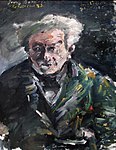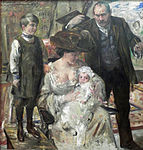Lovis Corinth
Lovis Corinth | |
|---|---|
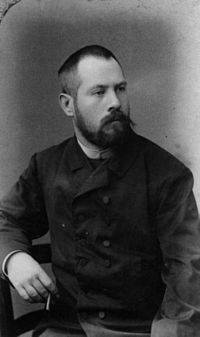 Corinth in 1887 | |
| Born | Franz Heinrich Louis 21 July 1858 Tapiau, Kingdom of Prussia |
| Died | 17 July 1925 (aged 66) Zandvoort, Netherlands |
| Nationality | German |
| Education | Academy of Fine Arts, Munich |
Lovis Corinth (21 July 1858 – 17 July 1925) was a German artist and writer whose mature work as a painter and printmaker realized a synthesis of impressionism and expressionism.
Corinth studied in Paris and Munich, joined the Berlin Secession group, later succeeding Max Liebermann as the group's president. His early work was naturalistic in approach. Corinth was initially antagonistic towards the expressionist movement, but after a stroke in 1911 his style loosened and took on many expressionistic qualities. His use of color became more vibrant, and he created portraits and landscapes of extraordinary vitality and power. Corinth's subject matter also included nudes and biblical scenes.
Early life
Corinth was born Franz Heinrich Louis on 21 July 1858 in Tapiau, in the Province of Prussia in the Kingdom of Prussia. The son of a tanner, he displayed a talent for drawing as a child. In 1876 he went to study painting in the academy of Königsberg. Initially intending to become a history painter, he was dissuaded from this course by his chief instructor at the academy, the genre painter Otto Günther.[1] In 1880 he traveled to Munich, which rivaled Paris as the avant-garde art center in Europe at the time. There he studied briefly with Franz von Defregger before gaining admission to the Academy of Fine Arts Munich, where he studied under Ludwig von Löfftz.[1] The realism of Corinth's early works was encouraged by Löfftz's teaching, which emphasized careful observation of colors and values.[1] Other important influences were Courbet and the Barbizon school, through their interpretation by the Munich artists Wilhelm Leibl and Wilhelm Trübner .
Except for an interruption for military service in 1882–83, Corinth studied with Löfftz until 1884.[1] He then traveled to Antwerp, where he greatly admired the paintings of Rubens, and then in October 1884 to Paris where he studied under William-Adolphe Bouguereau and Tony Robert-Fleury at the Académie Julian.[2] He concentrated especially on improving his drawing skills, and made the female nude his frequent subject. He was disappointed, however, in his repeated failure to win a medal at the Salon, and returned to Königsberg in 1888 when he adopted the name "Lovis Corinth".[3]
Career


In 1891, Corinth returned to Munich, but in 1892 he abandoned the Munich Academy and joined the Munich Secession. In 1894 he joined the Free Association, and in 1899 he participated in an exhibition organized by the Berlin Secession. These nine years in Munich were not his most productive, and he was perhaps better known for his ability to drink large amounts of red wine and champagne.
Corinth moved to Berlin in 1900, and had a one-man exhibition at a gallery owned by Paul Cassirer. In 1902 at the age of 43, he opened a school of painting for women and married his first student, Charlotte Berend, some 20 years his junior. Charlotte was his youthful muse, his spiritual partner, and the mother of his two children. She had a profound influence on him, and family life became a major theme in his art. Another of his students was Doramaria Purschian.
He published numerous essays on art history, and in 1908 published Das Erlernen der Malerei ("On Learning to Paint").[4]
In December 1911, he suffered a stroke, and was partially paralyzed on his left side. Thereafter he walked with a limp, and his hands displayed a chronic tremor.[5] With the help of his wife, within a year he was painting again with his right hand. His disability inspired in the artist an intense interest in the simple, intimate things of daily life. In the summer of 1919, for example, he produced a cycle of casual etchings of his family in their country home.[5] It was also at this time that landscapes became a significant part of his oeuvre. These landscapes were set at the Walchensee, a lake in the Bavarian Alps where Corinth owned a house. Their lively picturing, in bright colors, tempt many to consider the Walchensee series as his best work.
He painted numerous self-portraits, and made a habit of painting one every year on his birthday as a means of self-examination.[6] In many of his self-portraits he assumed guises such as an armored knight (The Victor, 1910), or Samson (The Blinded Samson, 1912).[7]
Not all of Corinth's works were appreciated in his lifetime: upon learning of his death, Danish critic Georg Brandes wrote in a letter to his secretary[8] that it was Corinth's "punishment for such a wretched portrait of myself".[9]
From 1915–25, he served as President of the Berlin Secession.[10] In 1920 an anthology of his art-historical writings was published in Berlin.[11] In 1922 his works were exhibited in the Venice Biennale.[12] On 15 March 1921 Corinth received an honorary doctorate from the University of Königsberg. In 1925, he traveled to the Netherlands to view the works of his favorite Dutch masters.[1] He caught pneumonia and died in Zandvoort. He was buried at Stahnsdorf South-Western Cemetery near Berlin.
Printmaking
Corinth explored every print technique except aquatint; he favored drypoint and lithography. He created his first etching in 1891 and his first lithograph in 1894. He experimented with the woodcut medium but made only 12 woodcuts, all of them between 1919 and 1924.[13] He was quite prolific, and in the last 15 years of his life he produced more than 900 graphic works, including 60 self-portraits. The landscapes he created between 1919 and 1925 are perhaps the most desirable images of his entire graphic oeuvre.
Legacy

The house where Corinth was born is still in the town of Tapiau, which is now called Gvardeysk, and located in Kaliningrad Oblast, Russia.
In 1910 Corinth had donated the painting Golgatha for the altar of the church of his birthplace, Tapiau. At the end of the Second World War, when the Red Army invaded East Prussia, this painting disappeared without trace. Tapiau was among the few East Prussian places not devastated by the war, which makes it likely that the painting was looted rather than destroyed.
In 1926, a commemorative exhibition of Corinth's paintings and watercolors was presented at the Nationalgalerie in Berlin, and an exhibition of his prints and drawings was held at the Berlin Academy.[14] By 1930 the Nationalgalerie acquired several major paintings by Corinth in addition to those already in its collection.[15]
During the Third Reich, Corinth's work was condemned by the Nazis as degenerate art. In 1937, Nazi authorities removed 295 of his works from public collections, and transported seven of them to Munich where they were displayed in March 1937 in the Degenerate Art Exhibition.[16]
In 2007, the German city of Hanover returned a painting by Corinth to the heirs of Jewish collector Curt Glaser, who sold it in 1933 to fund his escape from the Nazis. The painting from 1914, Römische Campagna [de] (Roman Landscape), was handed to Glaser's heirs, represented by his U.S.-based niece and her daughter.[17]
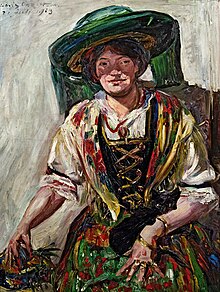
In 2015 heirs of Holocaust victims Thea and Fritz Goldschmidt made a restitution claim for Covinth's Tyrolean Woman with Cat” (“Tirolerin mit Katze”) after the painting appeared at the Im Kinsky auction house in Vienna on sale from an anonymous owner.[18] The Austrian auction house refused to say who bought the looted painting. The painting is listed on the German Lost Art Foundation Lostart Database[19] and on the Monuments Men Foundation's "Most Wanted List" of stolen art.[20]
In June 2021, the Royal Museums of Fine Arts of Belgium in Brussels agreed to return Corinth's 1913 Blumenstilleben (Still Life with Flowers) to the heir of Gustav and Emma Mayer, who were persecuted by the Nazis and forced to flee because of their Jewish heritage.[21][22]
Galleries
Landscapes and still lifes
-
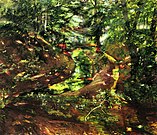 Forest Interior in Bernried (1892), oil on canvas, 94 × 110 cm., Galerie G. Paffrath, Düsseldorf
Forest Interior in Bernried (1892), oil on canvas, 94 × 110 cm., Galerie G. Paffrath, Düsseldorf -
 At Unter Schäftlarn on the Isar (1896), oil on canvas, 60 x 82 cm., Lenbachhaus, in Munich
At Unter Schäftlarn on the Isar (1896), oil on canvas, 60 x 82 cm., Lenbachhaus, in Munich -
 Swimming Facility in Horst-Ostsee (1902), oil on canvas, Museum Georg Schäfer, Schweinfurt
Swimming Facility in Horst-Ostsee (1902), oil on canvas, Museum Georg Schäfer, Schweinfurt -
 Blooming Cottage Garden (1904), oil on canvas, 76 x 100 cm., Museum Wiesbaden
Blooming Cottage Garden (1904), oil on canvas, 76 x 100 cm., Museum Wiesbaden -
 Hangover Breakfast (1913), oil on cardboard, 52 x 69 cm., private collection
Hangover Breakfast (1913), oil on cardboard, 52 x 69 cm., private collection -
 Flower Basket with Amaryllis, Lilac, Roses and Tulips (1914), oil on canvas, 109.4 x 138.8 cm., collection unknown
Flower Basket with Amaryllis, Lilac, Roses and Tulips (1914), oil on canvas, 109.4 x 138.8 cm., collection unknown -
 Walchensee Panorama, View from the Pulpit (1924), oil on canvas, 100 x 200 cm., Wallraf–Richartz Museum, Cologne
Walchensee Panorama, View from the Pulpit (1924), oil on canvas, 100 x 200 cm., Wallraf–Richartz Museum, Cologne -
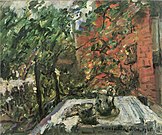 Vespers on the Balcony (1925), oil on canvas, 49 × 60 cm., Berlinische Galerie, Berlin
Vespers on the Balcony (1925), oil on canvas, 49 × 60 cm., Berlinische Galerie, Berlin
Figures and portraits
-
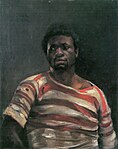 Negro Othello (1884), oil on canvas, 78 x 58.5 cm., Lentos Art Museum, Linz
Negro Othello (1884), oil on canvas, 78 x 58.5 cm., Lentos Art Museum, Linz -
 Male Nude (1886), oil on canvas, 85 x 55 cm., Yale University Gallery, New Haven,
Male Nude (1886), oil on canvas, 85 x 55 cm., Yale University Gallery, New Haven, -
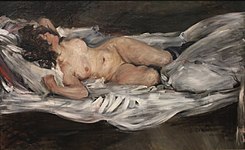 Reclining Female Nude (1899), oil on canvas, 75.5 cm (29.7 in); Width: 120.5 cm., Kunsthalle Bremen
Reclining Female Nude (1899), oil on canvas, 75.5 cm (29.7 in); Width: 120.5 cm., Kunsthalle Bremen -
 Count Eduard von Keyserling (1900), oil on canvas, 79.5 × 75.5 cm., Städtische Galerie Lenbachhaus, Munich
Count Eduard von Keyserling (1900), oil on canvas, 79.5 × 75.5 cm., Städtische Galerie Lenbachhaus, Munich -
 Group of Friends by Lovis Corinth (1904), oil on canvas, Albertinum, Dresden
Group of Friends by Lovis Corinth (1904), oil on canvas, Albertinum, Dresden -
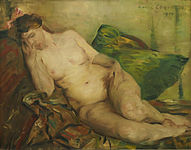 Reclining Nude (1910), oil on canvas, Landesmuseum Hannover, Hanover
Reclining Nude (1910), oil on canvas, Landesmuseum Hannover, Hanover -
 Portrait of Mrs. Kaumann (1911), oil on canvas, 99 x 120 cm., Kunsthalle Kiel
Portrait of Mrs. Kaumann (1911), oil on canvas, 99 x 120 cm., Kunsthalle Kiel - Georg Brandes (1925), oil on canvas, 111 x 91.5 cm., Royal Museum of Fine Arts, Antwerp
Wife, family and self portraits
-
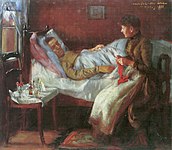 The Artist's Father in his Sickbed (1888), oil on canvas, 61 × 70 cm., Städelsches Kunstinstitut und Städtische Galerie, Frankfurt
The Artist's Father in his Sickbed (1888), oil on canvas, 61 × 70 cm., Städelsches Kunstinstitut und Städtische Galerie, Frankfurt -
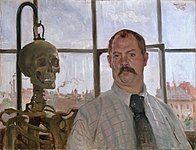 Self-Portrait with Skeleton (1896), oil on canvas, 66 x 86 cm, Städtische Galerie im Lenbachhaus
Self-Portrait with Skeleton (1896), oil on canvas, 66 x 86 cm, Städtische Galerie im Lenbachhaus -
 Charlotte in a White Dress (1902), oil on canvas, 105 x 54 cm., Stiftung Stadtmuseum, Berlin
Charlotte in a White Dress (1902), oil on canvas, 105 x 54 cm., Stiftung Stadtmuseum, Berlin -
 Self Portrait with his Charlotte Berend and Champagne Glass (1902), oil on canvas, 97 × 107 cm., private collection
Self Portrait with his Charlotte Berend and Champagne Glass (1902), oil on canvas, 97 × 107 cm., private collection - The Artist and His Family (1909), oil on canvas, Niedersächsisches Landesmuseum, Hanover
-
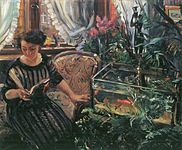 Lady at the Goldfish Basin (1911), oil on canvas, 74 x 90.5 cm., Österreichische Galerie
Lady at the Goldfish Basin (1911), oil on canvas, 74 x 90.5 cm., Österreichische Galerie -
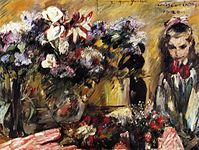 Flowers and Daughter Wilhelmine (1920), oil on canvas, 111 x 150 cm., Kunstmuseum Basel
Flowers and Daughter Wilhelmine (1920), oil on canvas, 111 x 150 cm., Kunstmuseum Basel -
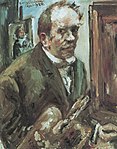 Self-portrait with Palette (1924), oil on canvas, 100 x 79 cm., Museum of Modern Art, New York
Self-portrait with Palette (1924), oil on canvas, 100 x 79 cm., Museum of Modern Art, New York
History painting
-
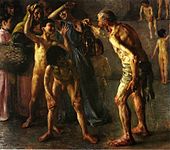 Diogenes (1892), oil on canvas, 178 x 208 cm., Ostdeutsche Galerie, Regensburg
Diogenes (1892), oil on canvas, 178 x 208 cm., Ostdeutsche Galerie, Regensburg -
 Bacchanalia (1896), oil on canvas, 117 x 204 cm., private collection
Bacchanalia (1896), oil on canvas, 117 x 204 cm., private collection -
 Salome (1900), oil on canvas, 127 × 147 cm., Museum der Bildenden Künste Leipzig
Salome (1900), oil on canvas, 127 × 147 cm., Museum der Bildenden Künste Leipzig -
 The Capture of Samson (1907), oil on canvas, 200 x 174 cm., Landesmuseum Mainz
The Capture of Samson (1907), oil on canvas, 200 x 174 cm., Landesmuseum Mainz -
 The Blinded Samson (1912), oil on canvas, 105 cm x 130 cm., Alte Nationalgalerie, Berlin
The Blinded Samson (1912), oil on canvas, 105 cm x 130 cm., Alte Nationalgalerie, Berlin -
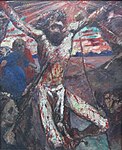 The Red Christ (1922), oil on panel, 129 x 108 cm., Pinakothek der Moderne, Munich
The Red Christ (1922), oil on panel, 129 x 108 cm., Pinakothek der Moderne, Munich -
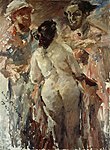 Susanna and the Elders (1923), oil on canvas, 150.5 x 111 cm., Lower Saxony State Museum
Susanna and the Elders (1923), oil on canvas, 150.5 x 111 cm., Lower Saxony State Museum -
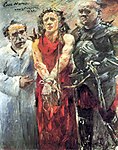 Ecce Homo (1925), oil on canvas, Kunstmuseum Basel
Ecce Homo (1925), oil on canvas, Kunstmuseum Basel
See also
Notes
- ^ a b c d e Makela
- ^ Corinth, Schuster, Vitali, & Butts 1996, p. 12.
- ^ Corinth, Schuster, Vitali, & Butts 1996, p. 13.
- ^ Corinth, Schuster, Vitali, & Butts 1996, p. 16.
- ^ a b Holland Cotter (12 June 1992), German Artist Haunted By a Threatening World New York Times.
- ^ Corinth, Schuster, Vitali, & Butts 1996, p. 142.
- ^ Corinth, Schuster, Vitali, & Butts 1996, pp. 41–42.
- ^ Rung, Gerda, p. 211
- ^ "Portrait of Georg Brandes - Lovis Corinth Paintings". www.paintingmania.com.
- ^ Corinth, Schuster, Vitali, & Butts 1996, p. 19.
- ^ Corinth, Schuster, Vitali, & Butts 1996, p. 20.
- ^ Corinth, Schuster, Vitali, & Butts 1996, p. 21.
- ^ Corinth, Schuster, Vitali, & Butts 1996, p. 369.
- ^ Corinth, Schuster, Vitali, & Butts 1996, p. 22.
- ^ Corinth, Schuster, Vitali, & Butts 1996, p. 23.
- ^ Corinth, Schuster, Vitali, & Butts 1996, pp. 23–24.
- ^ 1914 painting is returned to heirs Los Angeles Times, 25 September 2007.
- ^ "A Chicago family's search for art lost to the Holocaust". www.lootedart.com. Retrieved 7 February 2024.
- ^ "Tirolerin mit Katze | Lost Art-Datenbank". www.lostart.de. Retrieved 7 February 2024.
Provenienz: Sammlung Carl Steinbarth, Berlin; Kunsthandlung Hugo Moser, Berlin; Fritz Goldschmidt, Breslau; Privatsammlung; 29.11.2006 Lempertz, Köln, Lot 65; 17.06.2008 Kinsky Kunst Auktionen, Wien, Lot 139; Verbleib unbekannt
- ^ "Monuments Men and Women Foundation I WWII Most Wanted Art™ | Lovis Corinth". MonumentsMenWomenFnd. Retrieved 7 February 2024.
- ^ AFP. "Belgium returns stolen art to German Jewish family". www.timesofisrael.com. Archived from the original on 2 June 2021. Retrieved 3 June 2021.
- ^ Presse, AFP-Agence France. "Belgium Returns Stolen Art To German Jewish Family". www.barrons.com. Retrieved 3 June 2021.
References
- Corinth, L., Schuster, P.-K., Vitali, C., & Butts, B. (1996). Lovis Corinth. Munich: Prestel. ISBN 3-7913-1682-6
- Corinth, L., Uhr, Horst, Berkeley, Los Angeles, Oxford: University of California Press, 1990. ISBN 0-520-06776-2
- Makela, Maria. "Corinth, Lovis." Grove Art Online. Oxford Art Online. Oxford University Press.
- Rung, Gertrud. "Georg Brandes i Samvær og Breve". Copenhagen: Gyldendalske Boghandel Nordisk Forlag, 1930.
External links


- Gallery at "Museumsportal Schleswig-Holstein"
- Gallery of works by Lovis Corinth
- Corinth Gallery at MuseumSyndicate Archived 7 January 2009 at the Wayback Machine
- German masters of the nineteenth century : paintings and drawings from the Federal Republic of Germany, a full text exhibition catalog from The Metropolitan Museum of Art, which contains material on Lovis Corinth (no. 13–16)
- v
- t
- e
- Innocence (1890)
- Susanna in the Bath (1890)
- Self-Portrait with Skeleton (1896)
- Butcher Store in Schäftlarn on the Isar (1897)
- Young Woman with Cats (1904)
- Carmencita (1924)















